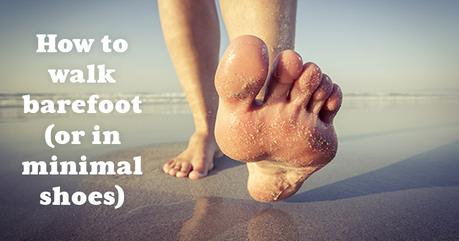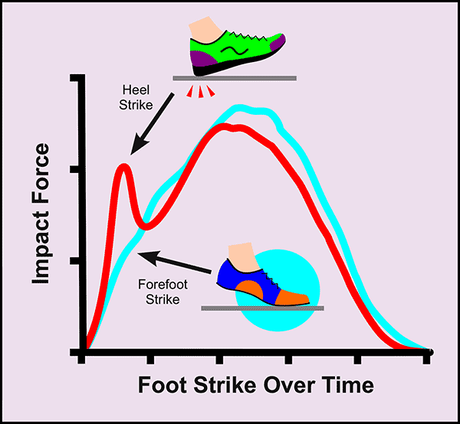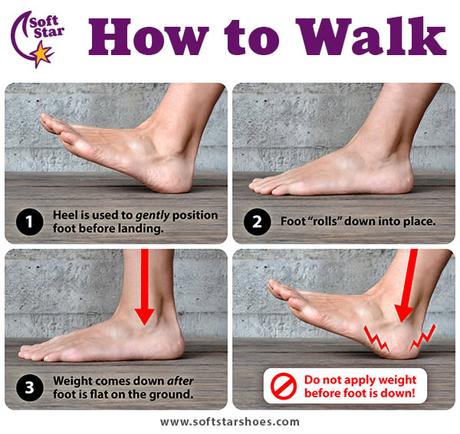
I know, the title of this post may sound condescending. After all, you probably have a lot of experience walking—several decades, even. But bear with me, because even though I’ve been walking since the late 70s I recently learned I wasn’t pulling it off as well as I thought.
I had the honor a couple years ago to take a running workshop with two gurus in the field of minimalist and barefoot running: podiatrist and Correct Toes inventor Dr. Ray McClanahan and physical therapist Dr. Sanatan Golden. One class, led by Dr. Golden, focused entirely on walking. While this was not what I expected to cover in a running workshop, it turned out to be one of the most beneficial sessions for me.
It also answered a question that had nagged me for some time: how should I walk while barefoot or in minimalist shoes?

It would seem logical that walking would be the same way, right? After all, if landing forefoot on a running step made such a notable difference in impact, then wouldn’t the same be true at a slower pace, too? Possibly, but anyone who has ever tried landing forefoot at a casual walking speed will immediately realize how awkward it feels. It requires you to almost walk on your tippy-toes, and it guarantees some funny looks as you struggle to stroll down the street.
And that’s why I still walked with a heel strike even after I started forefoot running in Soft Stars. I felt a pang of pain in my heel with every step, but I didn't see any other alternative... until the workshop.
In the class, Dr. Golden showed us that a forefoot strike is indeed very practical when you're running because your torso is leaning forward and your center of gravity comes down over the front of your foot with every strike. In walking, however, we aren't leaning forward and have the opportunity to use our heels in a different way. Specifically, your heel pad should touch the ground gently, then act as a guide to lower the rest of your foot down. Only then, when the toes are flat and in place, should you let your weight down.
And this is why we have padded heels—not for running, but for walking.
That’s it… the secret to healthy barefoot/minimalist walking:
- Use your heel to gently position your foot landing.
- Roll your foot down into place.
- Only after your entire foot is flat on the ground, apply your weight onto it.
If you’re like me, and most people who grow up wearing shoes with thickly cushioned heels, then you’ve probably developed the nasty habit of doing this in reverse by letting your weight down on your heel as soon as it comes in contact with the ground, before the rest of your foot is in place. Doing so adds excessive pressure onto your heel that can lead to pain or injury. Your whole foot should be absorbing that weight, not just your heel. Here's a little infographic showing the process:

I didn’t find it hard to change my walking pattern when I moved slowly and stayed focused on it, but as soon as I picked up speed to a normal pace and let my attention drift elsewhere I quickly reverted back to the old heel pounding. After all, this whole process happens in a fraction of a second. Dr. Golden gave us a few drills to help us make it a habit (shown in the video below), but the single best aid I had was this visualization technique:
Imagine you’re walking on ice.
When walking on slippery surfaces, we often unknowingly switch to this heel-first-weight-second technique. That happens because pushing your weight down with your heel puts the pressure down at an angle, leaving you susceptible to slipping. Putting your foot down before your weight, however, gives you a nice base for an almost vertical application of your weight, and makes slipping less likely.
Another tip: If you have trouble doing this then try bending your knees ever-so-slightly more than usual. It's not very easy to walk gently if your knees are over-extended, as many people do.
It took some practice, but I’ve now made this new method my natural gait. And the heel pain I used to feel when walking barefoot or in my Soft Stars is completely gone.
If you'd like more details, or want to learn the drills we used to make this walking technique a habit, then you're in luck. A colleague of Dr. McClanahan's recorded the whole class and posted it on the Correct Toes Youtube channel for all to see:
(I'm the tall lanky guy with the afro in the red shorts)
What do you think? Do these tips help you? Are they totally absurd? Is there another way to walk? Let us know!
Related Posts:
- Study: Shoe Orthotics Do NOT Prevent Back Pain, But Exercise Does
- 8 Benefits of Walking and Running Barefoot on Sand
- We're Staging a Flip-Flop Intervention!

